Sistema de calefacción y refrigeración para reactores de vidrio encamisado de doble capa
In chemical experiments and industrial production, glass reactor is one of the commonly used experimental equipment. Among them, the double-layer jacketed glass reactor has better temperature control performance and experimental results due to its unique structure.
Structure of double-layer jacketed glass reactor
The double-layer jacketed glass reactor is mainly composed of an inner tank, an outer jacket, a stirrer, sealing materials and other parts. Among them, the inner tank is used to hold chemical reagents and reactants, and the outer jacket plays the role of insulation and temperature control. The design of the double-layer jacket structure makes the reactor have good thermal insulation performance, which can effectively reduce heat loss and improve the stability and safety of the experiment.
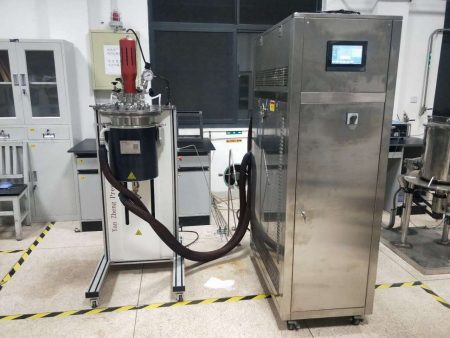
Temperature control method of double-layer jacketed glass reactor
1. Heating by electric heating mantle
Electric heating mantle heating is achieved by wrapping an electric heating mantle outside the reactor. Heating mantles are usually made of metal materials and equipped with intelligent temperature controllers that can set the temperature according to experimental needs. By heating the electric heating mantle, the reactants can react at the set temperature. Since the electric heating mantle has the advantages of uniform heating and adjustable temperature, electric heating mantle heating is one of the commonly used heating methods for double-layer jacketed glass reactors.
2. Hot water circulation heating
Hot water circulation heating is a method of heating by introducing hot water into the reactor jacket. Hot water usually enters the reactor jacket from an external pipe and circulates to keep the temperature constant. Hot water circulation heating has the advantages of high temperature control accuracy and uniform heating, and is suitable for experiments that require precise temperature control. However, hot water circulation heating requires additional water circulation equipment and heating equipment, and the operation is more complicated.
3. Oil bath heating
Oil bath heating is a method of heating by injecting thermal oil into the reactor jacket. Thermal oil has good thermal conductivity and stability, and can maintain a low viscosity at high temperatures. Oil bath heating has the advantages of high temperature control accuracy and uniform heating, and is suitable for experiments that require high-temperature heating. However, oil bath heating requires regular replacement of thermal oil and cleaning of the jacket, which is cumbersome to operate.
4. Refrigeration and heating circulator
Dynamic temperature control from -120℃ to +300℃, rapid cooling and heating with the same heat transfer fluid. Fully sealed pipelines reduce the demand for thermal fluid, and the expansion tank does not participate in circulation. The heat transfer fluid temperature output can be dynamically controlled based on the real-time temperature of the external sensor. It can handle exothermic or endothermic reactions, has high efficiency and stability, reliable and repeatable temperature control curves, magnetic drive pump, no shaft seal leakage, and controllable circulation flow pressure. Siemens PLC module, slope temperature control, multi-stage program temperature control, high precision.

Selection of temperature control methods for double-layer jacketed glass reactors
When selecting the temperature control method for the double-layer jacketed glass reactor, it needs to be considered based on the specific conditions and needs of the experiment. If the experiment requires precise temperature control, you can choose hot water circulation heating or oil bath heating; if the experiment requires rapid temperature rise, you can choose an integrated refrigeration and heating cycle machine. In addition, the safety and environmental protection of the experiment need to be considered, and safe and environmentally friendly heating methods should be given priority.
In short, the double-layer jacketed glass reactor is an important experimental equipment, and the choice of its temperature control method directly affects the success or failure of the experiment and the repeatability of the results. Therefore, in actual operation, it is necessary to choose an appropriate temperature control method according to the specific situation to ensure the accuracy and reliability of the experiment. At the same time, it is necessary to strengthen the maintenance of equipment to ensure the normal operation and service life of the equipment.
Ofrecemos diseño y fabricación de sistemas completos de control de temperatura. Desde modelos estándar hasta productos personalizados completos de hasta 900 toneladas. Nos especializamos en el servicio al cliente y nos dedicamos a ayudar a cada cliente a tener el sistema de control de temperatura óptimo para su necesidad específica.
Ofrecemos soluciones personalizadas no estándar. Disponemos tanto de enfriadoras individuales como de unidades combinadas de refrigeración y calefacción.
Correo electrónico: lilia@lneya.com WeChat ID: +8615251628237 WhatsApp: +86 17851209193


Sistemas de refrigeración y calefacción (serie SUNDI)
- Rango de temperatura: -120℃ ~ +350℃
- Control inteligente de la temperatura de alta precisión
- Capacidad de refrigeración: 0,5 kW ~ 1200 kW
- Sistema totalmente cerrado para prolongar la vida útil del fluido térmico
- Cada dispositivo se somete a pruebas de carga durante más de 12 horas
| Temperatura | Serie -10 ~ +150°C | Serie -25 ~ +200°C | Serie -25 ~ +300°C | Serie -45 ~ +250°C | Serie -45 ~ +300°C | Serie -60 ~ +250°C | Serie -60 ~ +300°C | Serie -70 ~ +250°C | Serie -80 ~ +250°C | Serie -90 ~ +250°C | Serie -100 ~ +100°C | ||
| Capacidad de refrigeración | 1,5 ~ 15 kW | 1 ~ 200 kW | 1 ~ 200 kW | 0,45 ~ 200 kW | 0,9 ~ 25 kW | 0,25 ~ 60 kW | 0,75 ~ 25 kW | 0,4 ~ 15 kW | 0,3 ~ 80 kW | 0,2 ~ 80 kW | 0,45 ~ 80 kW | ||
| Nota: Se puede personalizar cualquier rango de temperatura de -150℃ ~ +350℃ y cualquier capacidad de refrigeración. | |||||||||||||
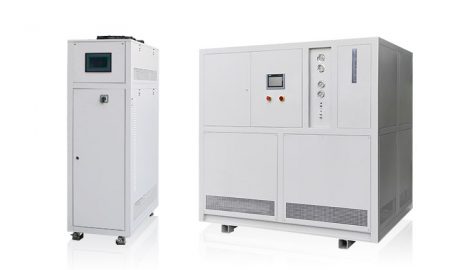
Sistemas de refrigeración y calefacción (serie WTD)
- (Microcanales / reactores tubulares especializados)
- Rango de temperatura: -70℃ ~ +300℃
- Bomba de circulación de alto rendimiento, efecto de control de temperatura más estable
- Amplia gama de temperaturas para satisfacer las necesidades de más industrias
- Cada dispositivo se somete a pruebas de carga durante más de 12 horas
| Temperatura | -70°C ~ +300°C | -45°C ~ +250°C | -70°C ~ +200°C | ||||||
| Capacidad de refrigeración | 1,1 ~ 7,5 kW | 1,5 ~ 5,5 kW | 11 ~ 50kW | ||||||
| Nota: Se puede personalizar cualquier rango de temperatura de -150℃ ~ +350℃ y cualquier capacidad de refrigeración. | |||||||||

Circuladores de refrigeración y calefacción
- Rango de temperatura: -45℃ ~ +250℃
- Compresor Emerson Copeland, calidad fiable
- Función de autodiagnóstico, múltiples dispositivos de protección de seguridad
- Sistema totalmente cerrado para prolongar la vida útil del fluido térmico
- Cada dispositivo se somete a pruebas de carga durante más de 12 horas
| Temperatura | Serie -25°C ~ +200°C | Serie -45°C ~ +250°C | |||||||
| Capacidad de refrigeración | 1 ~ 15 kW | 0,25 ~ 15 kW | |||||||
| Nota: Se puede personalizar cualquier rango de temperatura de -150℃ ~ +350℃ y cualquier capacidad de refrigeración. | |||||||||
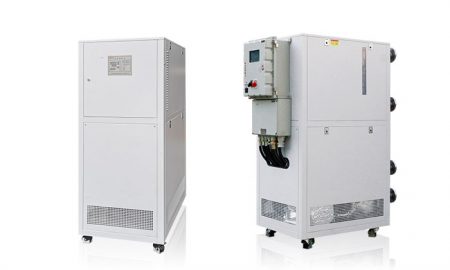
Termostatos de circulación
- Rango de temperatura: +50℃ ~ +300℃
- Gran superficie de intercambio de calor y rápida velocidad de calentamiento
- Función de autodiagnóstico, múltiples dispositivos de protección de seguridad
- Sistema de circulación cerrado, sin neblina de aceite a altas temperaturas
- Cada dispositivo se somete a pruebas de carga durante más de 12 horas
| Temperatura | +50°C ~ +170°C (serie UC) | +50°C ~ +300°C (serie UC) | +50°C ~ +300°C (serie UST) | ||||||
| Capacidad de calefacción | 5,5 ~ 15 kW | 3,5 ~ 130 kW | 3,5 ~ 95 kW | ||||||
| Nota: Se puede personalizar cualquier rango de temperatura de -150℃ ~ +350℃ y cualquier capacidad de refrigeración. | |||||||||
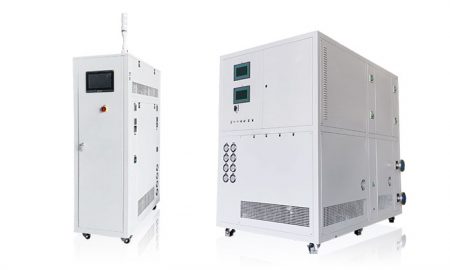
Serie TES (Control de temperatura para pruebas de combustible y aceite)
- Rango de temperatura: -85℃ ~ +250℃
- Controlador PLC Siemens y accesorios de otras marcas
- Función de autodiagnóstico, múltiples dispositivos de protección de seguridad
- Sistema de circulación totalmente cerrado, sin neblina de aceite a altas temperaturas
- Cada dispositivo se somete a pruebas de carga durante más de 12 horas
| Temperatura | Serie -45°C ~ +250°C | Serie -85°C ~ +200°C | Serie -60°C ~ +200°C | ||||||
| Capacidad de refrigeración | 0,3 ~ 25 kW | 0,25 ~ 25 kW | 3 ~ 60kW | ||||||
| Nota: Se puede personalizar cualquier rango de temperatura de -150℃ ~ +350℃ y cualquier capacidad de refrigeración. | |||||||||
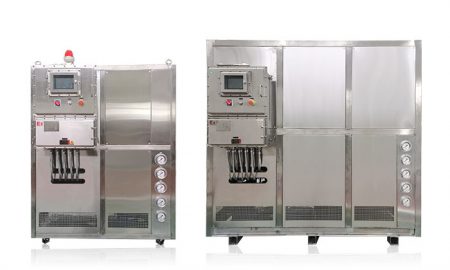
TCU Sistema de control de temperatura multirreactores
- Rango de temperatura: -120℃ ~ +250℃
- Control de temperatura hermético y repetible
- Sistema auxiliar de aceite térmico de calefacción eléctrica incorporado
- Añade módulos de intercambio de calor por fuente de frío y calor en función de las necesidades
- Cada dispositivo se somete a pruebas de carga durante más de 12 horas
| Temperatura | Serie -45°C ~ +250°C | Serie -120°C ~ +250°C | Sistema de control de temperatura personalizado | RT+10°C ~ +135°C | |||||
| Capacidad de calefacción | 25 ~ 80 kW | 25 ~ 80 kW | A medida | 25 ~ 300 kW | |||||
| Nota: Se puede personalizar cualquier rango de temperatura de -150℃ ~ +350℃ y cualquier capacidad de refrigeración. | |||||||||

Enfriadoras de recirculación / Criotermostatos
El enfriador puede utilizarse ampliamente en diversas industrias y laboratorios, y admite diseños personalizados.
| Temperatura | Serie -25°C ~ +30°C | Serie -45°C ~ +30°C | Serie -60°C ~ -20°C | Serie -80°C ~ -20°C | Serie -120°C ~ -70°C | ||||
| Capacidad de refrigeración | 0,8 ~ 30 kW | 0,75 ~ 12 kW | 0,4 ~ 6kW | 0,2 ~ 6kW | 0,3 ~ 5kW | ||||
| Nota: Se puede personalizar cualquier rango de temperatura de -150℃ ~ +350℃ y cualquier capacidad de refrigeración. | |||||||||
 Mini refrigeradores / Refrigeradores pequeños
Mini refrigeradores / Refrigeradores pequeños
El enfriador puede utilizarse ampliamente en diversas industrias y laboratorios, y admite diseños personalizados.
| Temperatura | -18°C ~ +30°C | Serie +5°C ~ +35°C | |||||||
| Capacidad de refrigeración | 0,35 ~ 0,9 kW | 1,8 ~ 50 kW | |||||||
| Nota: Se puede personalizar cualquier rango de temperatura de -150℃ ~ +350℃ y cualquier capacidad de refrigeración. | |||||||||

Refrigeradores de baja temperatura
Estamos especializados en la producción de refrigeradores de baja temperatura con un rango de control de temperatura de hasta -150°C, que pueden satisfacer las necesidades de refrigeración de diferentes industrias.
| Temperatura | Serie -25°C ~ -5°C | Serie -45°C ~ -10°C | Serie -60°C ~ -10°C | Serie -80°C ~ -30°C | Serie -110°C ~ -50°C | Serie -150°C ~ -110°C | |||
| Capacidad de refrigeración | 12 ~ 360 kW | 6 ~ 180 kW | 6 ~ 180 kW | 4 ~ 180kW | 2 ~ 120kW | 2,5 ~ 11 kW | |||
| Nota: Se puede personalizar cualquier rango de temperatura de -150℃ ~ +350℃ y cualquier capacidad de refrigeración. | |||||||||
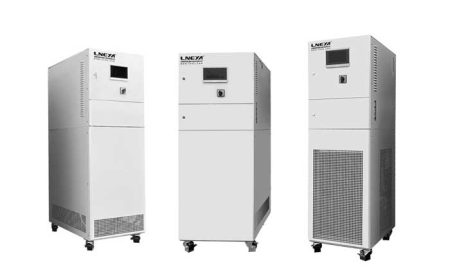
Refrigeradores de alta temperatura
El enfriador puede utilizarse ampliamente en diversas industrias y laboratorios, y admite diseños personalizados.
| Temperatura | +5°C ~ +40°C | -25°C ~ +40°C | -45°C ~ +40°C | -80°C ~ +80°C | -100°C ~ +80°C | ||||
| Capacidad de refrigeración | 6 ~ 40kW | 2 ~ 15kW | 1 ~ 8kW | 0,6 ~ 3 kW | 1,5 ~ 3 kW | ||||
| Nota: Se puede personalizar cualquier rango de temperatura de -150℃ ~ +350℃ y cualquier capacidad de refrigeración. | |||||||||
 LNEYA
LNEYA
 简体中文
简体中文


















































































